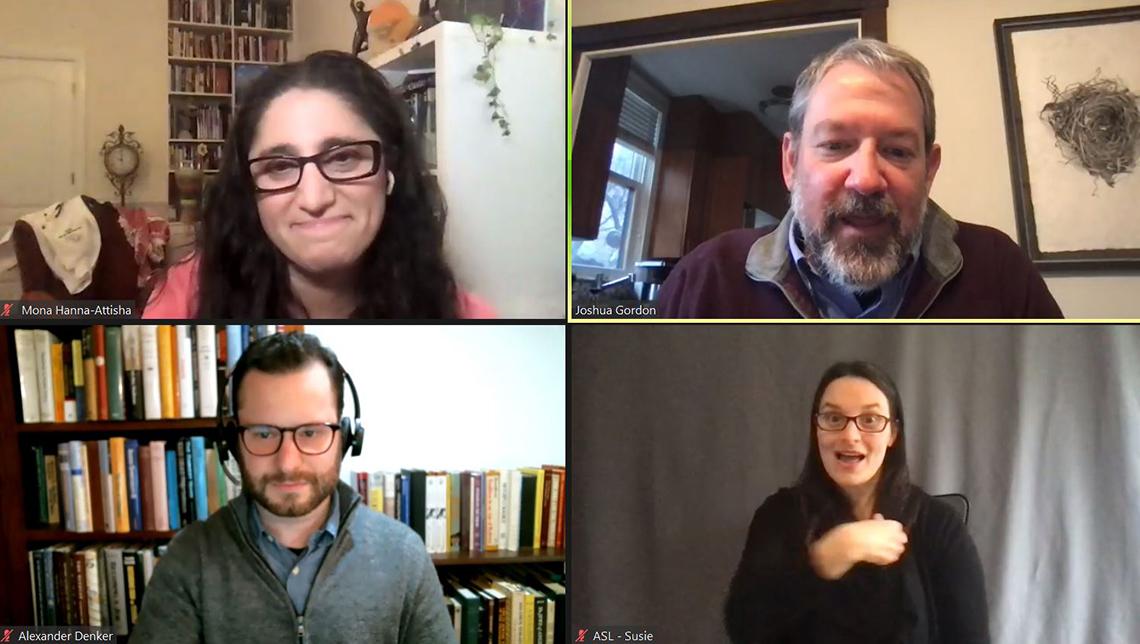Pediatrician Who Uncovered Flint Water Crisis Recounts Experience

In the summer of 2015, Dr. Mona Hanna-Attisha was drinking a glass of wine with a high school friend in Flint, Mich. Her pal, a drinking water expert, told her the tap water in Flint wasn’t treated properly and probably contained lead.
“When I heard about lead, my life changed,” said Hanna-Attisha, a pediatrician and founder and director of the Michigan State University-Hurley Children’s Hospital Pediatric Public Health Initiative, during a recent NIMH Director’s Innovation Speaker Series. “I became really consumed with what was happening with my Flint kids and how to best protect them.”
Thanks to the auto industry, Flint was once home to a thriving middle class. Like so many other post-industrial towns across America, the city suffered from decades of disinvestment and population loss. Now, 69 percent of Flint’s children under age five live in poverty.
During a budget crisis in 2014, the city switched its water supply from Lake Huron to the Flint River. After the change, residents began to raise concerns about the water’s color, odor and taste. In addition, the switch also led to an outbreak of Legionnaires’ disease that killed 12 people. The disease causes a serious form of pneumonia.

Photo: CAROL M. HIGHSMITH
At first, Hanna-Attisha assured her patients the water was safe because “there are people who wake up every day—who our tax dollars support—to make sure that when I turn on my tap in Flint or Bethesda or wherever I am, that my water is safe.” Her opinion soon changed.
Once her friend tipped her off about lead in the water, she had to act because there is no safe amount of lead for kids. Lead exposure can cause serious harm to children’s health, including damage to the brain and nervous system, delayed growth and development, and learning and behavior problems. In turn, these result in lower IQ, decreased ability to pay attention and underperformance in school.
“I knew that if I was going to make a difference, I would need science, data and facts in my pocket,” Hanna-Attisha said. “I quickly conducted the research to see if there was more lead in the bodies of our children.”
She reviewed blood for children younger than age five before and after Flint’s water source change and found that area kids’ blood lead levels were higher after the change. Disadvantaged areas had the greatest increases in blood lead levels. She knew she couldn’t afford to wait to present her research in an academic journal because the publishing process was too long.

Photo: CAROL M. HIGHSMITH
“I did something most doctors and scientists don’t usually do,” said Hanna-Attisha. “I literally walked out of my clinic with my white coat on and stood up in one of our hospital conference rooms where we usually have resident lectures. I shared the research that our kids are in harm’s way and I demanded action.”
After her press conference, state officials accused her of “slicing and dicing” data and “causing near hysteria.” They claimed her data set differed from theirs.
“I felt absolutely tiny and defeated. I began to second guess myself,” she recalled. “I think, especially so many women, we often talk about imposter syndrome. I felt like I shouldn’t have done this. Fortunately, I quickly realized this doesn’t have anything to do with me.”
This was about research, data and evidence. Each number wasn’t just a number—it was a child. “It was as if those kids jumped out of my spreadsheets, lifted me up and gave me the courage to keep going,” she said.
Eventually, the state concluded that their research was consistent with Hanna-Attisha’s findings. A federal emergency was declared to support the response to the water crisis and recovery. The state of Michigan and private donations also provided support.
“I don’t want to be vindicated,” she said. “I just want the kids to be protected. Our kids never should have had to go through this. I’m glad that we were able to expose all this, but it never should’ve happened in the first place.”
Flint residents feel betrayed by the people who were supposed to protect them, she added. They’re still angry. Many parents experience guilt because they gave contaminated water to their children.
At the height of the crisis, she was hardly ever home for her own two young daughters. They recognized that their mother was with their 6,000 siblings.

“I’ve been able to persevere with villages of support both at home and at work,” Hanna-Attisha said. At work, she surrounds herself with smart coworkers. At home, she has people who can help out and a list of babysitters. “It’s definitely not easy.”
For many working mothers, the Covid-19 pandemic “has thrown the idea of balance out the window.” It’s difficult for them to work and advance their careers while also caring for children.
Today, Hanna-Attisha is focused on developing programs that improve the health and development of children, including early education, health care, child care programs and parental education programs. For example, the nutrition prescription program she helped develop provides a $15 voucher for fruits and vegetables at a farmer’s market to every child who visits a health clinic.
“I don’t want to be known for uncovering the water crisis,” Hanna-Attisha said. “I want to be known for what we did next, which is our recovery.”
